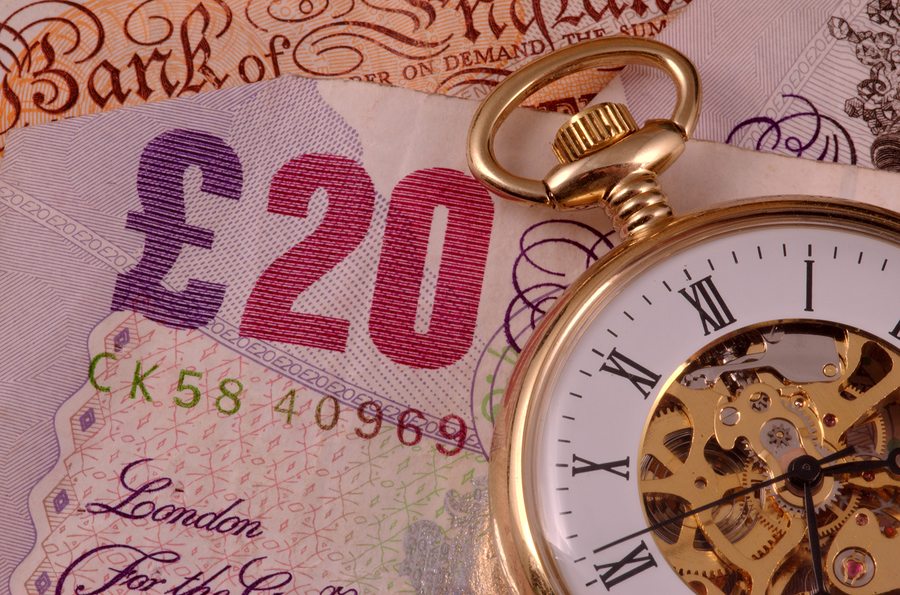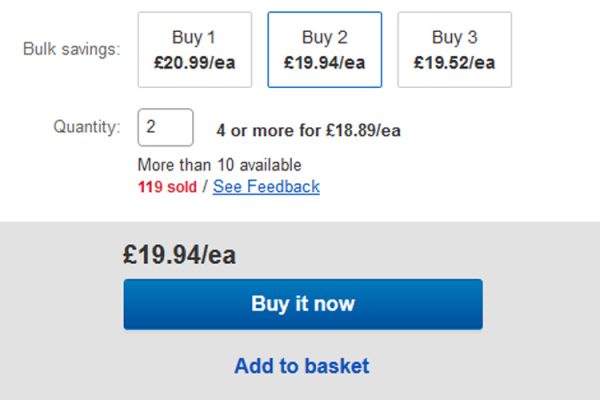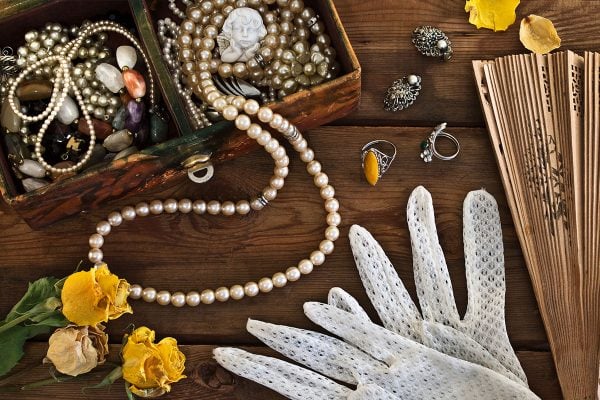Auctionbytes point to a report claiming that one in ten eBay transactions results in an unpaid item. Though I haven’t managed to see the actual report, I find the statistic literally incredible: even in the olden days before PayPal, when more than half my buyers paid by cheque and envelopes stuffed with dollars used to wing their way across the the Atlantic, I didn’t hit 10% NPB rate.
Now we do have PayPal, over my last thousand transactions, I’ve needed to file eight unpaid item disputes, only two of them were closed, and one of *them* paid up after she got her unpaid item strike. If my NPBs are 0.1%, that must mean some other sellers are averaging way above 10%.
So I thought I’d take a look at some ways to avoid unpaid eBay items. No doubt experienced sellers are already doing most of this, but I hope some newer sellers will pick up some tips. The golden rule is to give your buyer as many chances to pay, and as few excuses not to pay, as you possibly can…

Take PayPal
I remember so well, back in 2001, the first buyer who told me if she couldn’t pay with PayPal, she wasn’t going to pay at all. If you only accept cheques and postal orders, you’re going to have to deal with a lot of buyers who give you that same message: yes, you’ll have PayPal charges to deal with, but better to accept that upfront and allow for them in your pricing. Buyers don’t care about your PayPal fees; they want the speed, the convenience and the perceived security of the payment system that’s built into eBay. Give them what they want.
Give all the information up front
Most of all, this means quoting postage in your listings. If you ship worldwide, then list worldwide postage too, not just domestic (it’ll cut down on those pesky ASQs as well). And if you only ship on Tuesdays, state that too: you don’t want to have to cancel orders that people order on Thursday for the weekend.
Require immediate payment
“Immediate payment required” means that the item does not close until your buyer has actually paid, which can be very useful in ensuring all your sales result in payment. However, it does mean that buyers cannot combine multiple purchases, so is really only useful for those who only ever sell single items.
Offer an electronic alternative to PayPal
We’ve all heard it: “PayPal have mucked up my account.” Sometimes, it’s even true. If – for whatever reason – your buyer can’t access their PayPal account, you need to be able to offer them an alternative. Posting cheques and postal orders is so twentieth century, so have an electronic means of payment you can offer: Nochex are good, or offering to take credit cards over the phone can give you the opportunity to upsell a little too!
Use your buyer blocks
 eBay do to some extent let you control which buyers you want to deal with, in bidder management, as you can block bidders according to particular characteristics. Criteria vary from site to site, but on eBay UK, are:
eBay do to some extent let you control which buyers you want to deal with, in bidder management, as you can block bidders according to particular characteristics. Criteria vary from site to site, but on eBay UK, are:
- buyers in countries to which you don’t ship
- buyers with 2 unpaid item strikes in the last 30 days
- buyers with an overall negative feedback score (presumably this one will vanish shortly)
- buyers with no PayPal account
- buyers with no credit card on file
- buyers who’ve bought more than a set number of my items in the last ten days.
The last two controls may be selectively applied only to buyers with 5 or fewer feedbacks.
While it can be tempting to use as many buyer blocks as you can, it’s worth being a little more selective. If you sell craft items, for example, you probably want to leave the multiple purchases one alone. People who aren’t intending to sell don’t have much of an incentive to have a credit card on file (unless they’ve used it to verify their account instead of telephone verification). And blocking buyers from countries to which you don’t ship doesn’t guarantee that a UK-registered buyer won’t buy your mobile phone and then ask you to ship it to his nephew in Nigeria – but it does mean that the nephew can’t buy it for himself.
You can check who’s being hit by your buyer blocks; if too many buyers are being caught, you might want to consider relaxing your choices a little.
Keep communicating
I remember, a long time ago, Chris telling me his strategy for dealing with non-paying bidders. “I email them,” he said, “then I email them again. Then I phone them. I make it so they pay just to get me to go away.” If you’re selling more expensive items, a phone call to a non-paying bidder might just get things sorted: it should at least let you know if they’re *intending* to pay or not.
Even if you don’t want to phone your buyers, a schedule for dealing with items awaiting payment is important: I send a reminder after five days, another after seven, and file the UID on the tenth or eleventh (unless I know there’s a reason why they haven’t paid yet). A quick run through my unpaid items every morning means I stay on top of this and no buyer is allowed to think I’ve forgotten about them and will go away.
Forget about the word “dispute”
I wish eBay would change the word “dispute” to something more palatable, just as I wish they’d make the email they send the buyer when you open a UID a bit less snotty. But for now, sellers have to work to mitigate the effects of eBay’s attitude.
When you file a UID, *immediately* add to the dispute thread: a simple comment like “I’m sorry you haven’t been able to pay for these yet, please let me know what the problem is” tells your buyer that you’re someone who’s still prepared to communicate.
Whatever you do, there will still be the odd buyer who pays up after you’ve closed the dispute. If you have replicable stock and are willing to reverse the strike if the buyer pays you, then use the UID thread to let the buyer know this before you close the dispute.
I hope this has given you some ideas to reduce unpaid items in the future, but please share your own tips in the comments.









16 Responses
I still totally endorse the “credit control” side of getting paid. Email your buyer, send them an invoice, open an unpaid item dispute (which generates an email), add a comment (which generates another email), pull their contact details (which generates another email) and phone them. They’ve bid so make sure they’re given every opportunity to pay… and most of them will (If for no other reason that it’s easier to pay to get rid of you than it is to have constant reminders that they haven’t paid 😉 )
I’m still in awe of the 10% unpaid items – that’s inexcusable and I blame the sellers in part 🙁
I have no difficulty at all in believing this, its all very well for established powersellers selling on BIN with well thought out blocked bidder policies, to say they have low unpaid levels.
The average new seller who doesn’t know what they are doing and hasn’t followed your, admittedly, good advice has well in excess of 10% non payers, just from scammers trying to take advantage of them alone. Add to this to legitimate buyers who back out due to a bad or undescriptive listing.
This is a site wide average, and in some categories (not beads or laser printers) such as mobile phones or camcorders only a few buyers are genuine without restrictive buyer requirements.
(I agree with all your advice, but the casual seller just doesn’t want to do this and they are the ones causing this statistic, ‘if i wanted to talk to buyers i’d stick a ad in loot’)
Peter, FYI I currently sell in some much more difficult categories than beads: even with a range of goods that are designed to and do appeal to 14-18 year olds (and French ones at that, who largely don’t have credit cards and *have* to post cheques) my NPB rate is still practically nil. If casual sellers “don’t want to get buyers to pay” then frankly I’d question what they’re doing, not selling on eBay, but trying to sell AT ALL.
I also question the accuracy of your statement that in some categories “only a few buyers are genuine”. I know that there are a lot of difficulties with scammers in mobile phones, for example, but you overstate the case in the extreme to conclude that scammers therefore make up the majority of buyers in those categories.
I sold a mobile phone a week ago for the first time
its a nightmare, there all as bent as a ragman,s trumpet
If I had not had a bit of savvy ,I would have been hung out to dry,
the neck of many was astounding with my feedback you would think they would not attempt the scams
I must admit the phone sold and I was paid quickly and the buyer was happy,
though I had my buyer requirments on nuclear attack level,
and only accepted paypal as payment
Thanks North, and that’s why I think even casual sellers should be doing most of the above. Saying “I’m an amateur” shouldn’t preclude you from taking care about what you’re doing.
Accepting PayPal is crucial for avoiding UPI’s ime. My former manager refused to let me accept PP because he didn’t trust it but I signed us up as soon as he left. An unforseen consequence was that our number of UPI’s (which I never calculated but seemed a heckuva lot higher than 10%) was immediately reduced to a trickle.
I would also add that the extent to which I will communicate with a buyer depends on their feedback. Many of my non-payers will have +ve feedback for an identical item which ended at the same time as mine but which they won for a slightly cheaper price. In such cases, I don’t feel it’s worth my time to badger them for payment – they have what they want, so are unlikely to pay up.
Also, if someone says they can’t pay straight away but should be able to ‘in a few days’ I like to get them to commit to paying before a specific date & tell them we will only guarantee to hold their goods until then. Otherwise, ‘a few days’ can turn into ‘a few weeks’ – and the longer they procrastinate, the less likely they are to pay.
In regards to Peter King’s comment, I would say that the statistic is due to sellers AND buyers. A lot of sellers are not communicative enough but when I do communicate with non-payers, I usually don’t get any answer!
ebays got this right when I first sold on ebay 25 %or 30% NPB was fairly regular, I cant remember the last time I had a non payer,
and I think thats down to ebay, rather than how I do things,
if they dont pay I dont badger them, lifes to short, I file a npb and leave it at that,
though filing a NPB in future could be suicidal, as there is nothing better than that dispute email from ebay to send a buyer off on one
That’s my main concern about the feedback changes – buyers responding to the UPI process with ‘leave me a strike & I’ll neg you’. I don’t think most of them know the score well enough to do that tbh but a few may. We’ll see.
I don’t think that’s going to be much of a problem as eBay have promised to step up action on non-performing buyers. Having something as blatent as feedback extortion in a UPI is probably more thant sufficient evidence for eBay to remove any neg subsequently left (and more than a little silly of any buyer that tries it) 🙂
It would have to be “open a UID and I’ll respond to it and neg you”, and as you say Sam, I don’t think many buyers are that savvy.
Nice to hear from a successful phone seller on this particular thread though 😀
I’m pretty agog at the 10% figure. And I wonder if it’s related to the survey. “What percentage of your sales go unpaid?”
“Oh gosh, off the top of my head? Maybe 10-15%? I dunno”
UPIs are generally perceived to be more prevalent than they actually are. I’m a casual seller and have had not 1 UPI for at least a year… and I’m not sure I have all these precautions in place.
It’s worth looking at the buyer side of this problem. Why aren’t they paying. I’d say it’s usually either a) they’ve forgotten or b) they don’t know how. Rarely is it malicious.
It’s worth looking at the buyer side of this problem.
Shhh… that’s next week 😉
The report is from Scott Devitt of Stifel, Nicolaus, so you’d hope he’s based it on more than seller anecdote.
Oops, sorry. 😆
I usually get less than one non-payer a month but this month it’s gone “through the roof”, 2 non-payers (one already NARU) and now a bounced cheque with no response from the buyer (and as my bank took 3 weeks to return the cheque of course they have the goods 🙁 )
I dunno what’s gone wrong lately!
UPI differ widely by price, chategory, country, culture, payment method accepted and probably some other variables. I have heard of 40% average UPI in real estate on ebay.com, 20-30% UPI in motors on ebay.com, and personally i know some ebay powersellers who have 10-15% in clothes on ebay.com. Benchmarks like these would be very helpful for sellers to have access to in order to maximize their selling and service potential on ebay.
I have heard UPIs of international sellers can be as high as 20% for clothes in Italy and Spain for US sellers selling on ebay.it and ebay.es. UPIs are generally the lowest in the UK and the US.